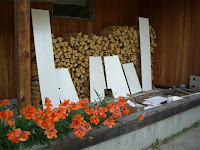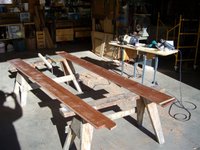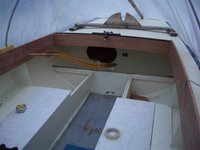
This Sunday morning both Marjorie and I were awake at 5:00AM having fallen into bed early due to a long day Saturday, working on the Etchells. I said "Lets get up and start early, I have a plan." I figured if we put another coat of paint on the boat's cockpit on early Sunday, then left it in the heated space until early Monday morning, it would dry. Some sheetrock tapers might come in Monday morning to fix some cracks and we have to be out of there.
We were at the warehouse an hour before the sun showed itself. The temperature was a couple of degrees below zero! I sanded the inside while Marjorie read the paper. Then she vacuumed in inside and wiped down the interior with solvent while I put primer on plywood that will be the "seats" and "bunks". Then I mixed the single-part polyurethane paint, the same off-white as the deck, and began painting about 10:30 AM. Marjorie went out to Costco, did some shopping, and brought us back a sandwich about 12:30, just when I was finished painting, AND ran out of paint!d We had lunch and rested in our camping chairs which we brought in, almost a month ago, when we moved into this space!
After lunch, we loaded tools, paint, lumber, table, saw horses, etc. etc. into the van. We had hauled a lot of stuff to the warehouse. Marjorie commented that we had used most of it.
We got home about 3:00PM to a glorious, sunny, Montana, winter day. The sun was very welcome as house had cooled to around 60 degrees because we were not home, we had not kept a fire going during the cold, cloudy weather. I put on some clean clothes as I was "heavy with sawdust and paint", and took a short nap followed by a shot of espresso.
I ran the snow blower to remove about 3-4 inches of snow from the driveway. I ran the snowblower out into the yard so I could stand a chance of getting the Etchells turned around and backed into her place. alongside the garage.
We returned to the warehouse near sunset and loaded the last of our tools and materials and swept, and dust-mopped the space, hoping to leave it at least as clean or better than we found it. The boat is ready for us to hook up our van to the trailer and bring it home.
Somewhat worrisome is the fact that last night as we tried to drive the van from the warehouse area onto Frontage road, the entry road was covered with a glaze of ice an inch thick, and the van could not get enough traction to pull itself out onto the highway. We are thinking, "Which is the most level route from the warehouse to our house?"

















































